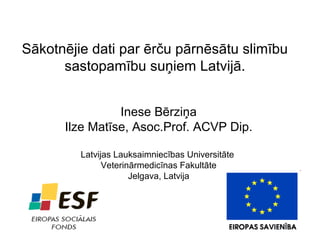
Ib jelgava 29oct 2010
- 1. Sākotnējie dati par ērču pārnēsātu slimību sastopamību suņiem Latvijā. Inese Bērziņa Ilze Matīse, Asoc.Prof. ACVP Dip. Latvijas Lauksaimniecības Universitāte Veterinārmedicīnas Fakultāte Jelgava, Latvija
- 2. Ērču pārnēsātas slimības (ĒPS) cilvēkiem Latvijā • 2009. gadā – Ērču encefalīts - 328 gadījumi – Laimas slimība – 720 gadījumi • Kopš 2001. gada – Anaplazmoze/erlihioze – 12 gadījumi
- 3. 17.7% 3.9% 0.8% 5% ?? 43,2% 7.2% 1% Publicēti gadījumi ĒPS suņiem Eiropā Anaplazmoze Borelioze Publicēti gadījumi
- 4. Metodoloģija • Suņi – Klīniski veseli (1.grupa, n=400) – Ar aizdomām par ĒPS (2.grupa, n~ 50) • Drudzis, letarģija, trombocitopēnija, klibums u.c. – Medību suņi (3.grupa, n~ 50) • Īpašnieku aptauja • Laboratoriskā izmeklēšana – Hematoloģija – IDEXX SNAP 4Dx • A.phagocytophilum, B.burgdorferi, E.canis, • D. Immitis – PĶR
- 5. Sākotnējie rezultāti: IDEXX SNAP4Dx • 1.grupa (n=161)* – 9.9 % (n= 16) A.phagocytophilum – 1.8% (n=3)B.burgdorferi – 0.6% (n=1) A.phagocytophilum un B.burgdorferi • 3.grupa (n=24)* – 12.5% (n=3) A.phagocytophilum * Antivielas pret A.phagocytophilum, B.burgdorferi
- 6. Sākotnējie rezultāti: IDEXX SNAP4Dx & PĶR • 2.grupa (n=22)* – 22.7% (n=5) A.phagocytophilum – 9.09% (n=2)Babesia spp. ^ – 4.5% (n=1) Babesia & A.phagocytophilum^ – 4.5% (n=1) A.phagocytophilum & E.canis – 4.5% E.canis (?) * Antivielas ^ RT PĶR (IDEXX Ludvigsburga, Vācija)
- 7. Izmeklētie klīniski veselie suņi
- 8. Sākotnējie rezultāti: hematoloģija – Anaplazmoze • Trombocitopēnija • Morulas granulocītos – Babezioze • Hemolītiska anēmija • Babēzijas eritrocītos *Mikroskopētas tikai 2.grupas suņu asinis
- 9. Pētījuma turpinājums • IDEXX SNAP 4Dx • Hematoloģija • Aptaujas datu analīze • PĶR analīze • Anaplazmozes patofizioloģijas pētījumi – Imunoķīmisku anaplazmozes diagnostikas metožu izstrāde
- 10. Kopsavilkums * statistiski nozīmīga atšķirība starp grupām (z=1.134, One-tailed z-test for two proportions) 1,8 4,5 9,1 12,5 9,9* 22,7* 0,0 5,0 10,0 15,0 20,0 25,0 Anaplazmoze Borelioze Erlihioze Babezioze Procenti 1.grupa 2.grupa 3.grupa
- 11. Secinājumi • Anaplazmoze ir samērā izplatīta suņiem Latvijā • Jāpopularizē profilaktisku pasākumu nozīme • Nepieciešams vairāk informācijas par B.burgdorferi seroprevalenci suņiem Latvijā • Babeziozes gadījumi no Latvijas neizceļojušiem suņiem nav konstatēti
- 12. Paldies par uzmanību! Šī pētījuma veikšanai piešķirts ESF mērķfinansējums
Editor's Notes
- Shortly I would like to mention the current situation with TBD in humans in Latvia. These diseases are very common and numbers are roughly the same for the last decade (in the 90ties there was an increase in the incidence). TBE and Lyme disease are the most commonly diagnosed diseases. Anaplasmosis/erlichiosis – only 12 cases in last 9 years and only one of these cases initially had anaplasmosis/erlichiosis as a differential diagnosis. So not enough information is around for humans and even more so for dogs.
- Detection methods and dog populations vary! Anaplasmosis in Nordic countries: Sweeden 17.7% dogs suspected to have sarcoptic mange were positive. UK – dogs suspected to have TBD Germany – healthy and sick dogs together Poland – dogs from Lyme borreliosis endemic area Baltic countries – no data. Borreliosis – In Poland and Finland – have been case reports. There are several papers on borrelia in ticks in Finland (but I could not find papers on dogs). Based on what our neibours have it is believable that we will have anaplasmosis and Lyme disease in our dogs. And probably babesiosis in those that are travelling.
- Clinically healthy dogs (group 1) and dogs with clinical signs suggestive of TBD (group 2) and hunting dogs (Group 3) were enrolled in the study. Blood was drawn from all dogs and analyzed hematologically (analyzer and microscopy) and with IDEXX SNAP 4Dx test which detects antibodies against Anaplasma phagocytophilum, Erlichia canis, Borrhelia burgdorferi and Dirofilaria immitis. Information regarding tick exposure and ectoparasite control habits was collected from the owners of the dogs enrolled in the study. PCR will be performed for those dogs that are clinically sick, have Anaplasma morulae in the blood and are seropositive on the SNAP test. (PCR testing will be done later in the study).
- Atšķirības starp grupām nav statistiski nozīmīgas, domājams, ka tas mainīsies palielinoties izmeklēto dzīvnieku skaitam. 1.Grupā – 16/161 = AP - 3/161= BB - 1= AP&BB 2.Grupa – 4/20=AP - 1/20=EC* - 1/20= AP&EC* 3.Grupa – 3/24 = AP
- As is described in the literature – our findings show that dogs with clinical anaplasmosis have significant thrombocytopenia.